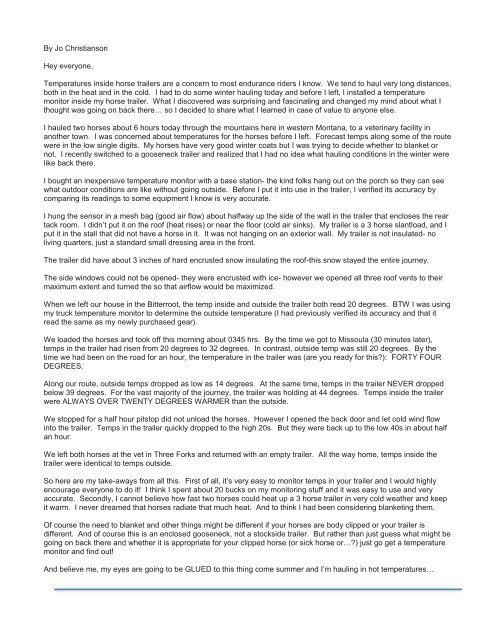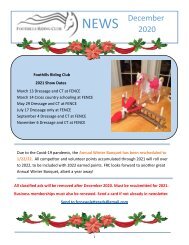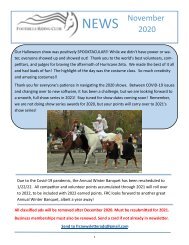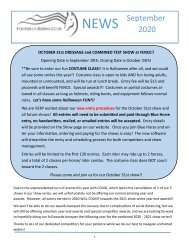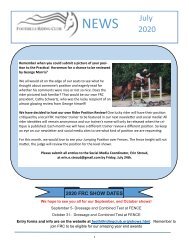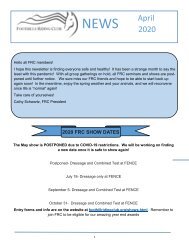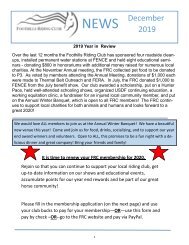December 2017 FRC Member Newsletter
Create successful ePaper yourself
Turn your PDF publications into a flip-book with our unique Google optimized e-Paper software.
By Jo Christianson<br />
Hey everyone,<br />
Temperatures inside horse trailers are a concern to most endurance riders I know. We tend to haul very long distances,<br />
both in the heat and in the cold. I had to do some winter hauling today and before I left, I installed a temperature<br />
monitor inside my horse trailer. What I discovered was surprising and fascinating and changed my mind about what I<br />
thought was going on back there… so I decided to share what I learned in case of value to anyone else.<br />
I hauled two horses about 6 hours today through the mountains here in western Montana, to a veterinary facility in<br />
another town. I was concerned about temperatures for the horses before I left. Forecast temps along some of the route<br />
were in the low single digits. My horses have very good winter coats but I was trying to decide whether to blanket or<br />
not. I recently switched to a gooseneck trailer and realized that I had no idea what hauling conditions in the winter were<br />
like back there.<br />
I bought an inexpensive temperature monitor with a base station- the kind folks hang out on the porch so they can see<br />
what outdoor conditions are like without going outside. Before I put it into use in the trailer, I verified its accuracy by<br />
comparing its readings to some equipment I know is very accurate.<br />
I hung the sensor in a mesh bag (good air flow) about halfway up the side of the wall in the trailer that encloses the rear<br />
tack room. I didn’t put it on the roof (heat rises) or near the floor (cold air sinks). My trailer is a 3 horse slantload, and I<br />
put it in the stall that did not have a horse in it. It was not hanging on an exterior wall. My trailer is not insulated- no<br />
living quarters, just a standard small dressing area in the front.<br />
The trailer did have about 3 inches of hard encrusted snow insulating the roof-this snow stayed the entire journey.<br />
The side windows could not be opened- they were encrusted with ice- however we opened all three roof vents to their<br />
maximum extent and turned the so that airflow would be maximized.<br />
When we left our house in the Bitterroot, the temp inside and outside the trailer both read 20 degrees. BTW I was using<br />
my truck temperature monitor to determine the outside temperature (I had previously verified its accuracy and that it<br />
read the same as my newly purchased gear).<br />
We loaded the horses and took off this morning about 0345 hrs. By the time we got to Missoula (30 minutes later),<br />
temps in the trailer had risen from 20 degrees to 32 degrees. In contrast, outside temp was still 20 degrees. By the<br />
time we had been on the road for an hour, the temperature in the trailer was (are you ready for this?): FORTY FOUR<br />
DEGREES.<br />
Along our route, outside temps dropped as low as 14 degrees. At the same time, temps in the trailer NEVER dropped<br />
below 39 degrees. For the vast majority of the journey, the trailer was holding at 44 degrees. Temps inside the trailer<br />
were ALWAYS OVER TWENTY DEGREES WARMER than the outside.<br />
We stopped for a half hour pitstop did not unload the horses. However I opened the back door and let cold wind flow<br />
into the trailer. Temps in the trailer quickly dropped to the high 20s. But they were back up to the low 40s in about half<br />
an hour.<br />
We left both horses at the vet in Three Forks and returned with an empty trailer. All the way home, temps inside the<br />
trailer were identical to temps outside.<br />
So here are my take-aways from all this. First of all, it’s very easy to monitor temps in your trailer and I would highly<br />
encourage everyone to do it! I think I spent about 20 bucks on my monitoring stuff and it was easy to use and very<br />
accurate. Secondly, I cannot believe how fast two horses could heat up a 3 horse trailer in very cold weather and keep<br />
it warm. I never dreamed that horses radiate that much heat. And to think I had been considering blanketing them.<br />
Of course the need to blanket and other things might be different if your horses are body clipped or your trailer is<br />
different. And of course this is an enclosed gooseneck, not a stockside trailer. But rather than just guess what might be<br />
going on back there and whether it is appropriate for your clipped horse (or sick horse or…?) just go get a temperature<br />
monitor and find out!<br />
And believe me, my eyes are going to be GLUED to this thing come summer and I’m hauling in hot temperatures…


